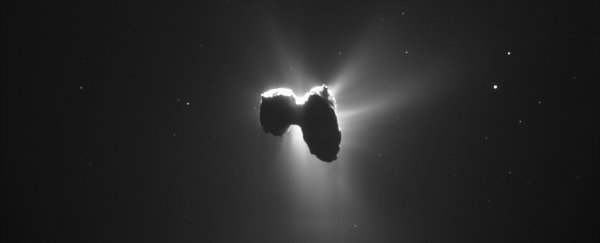Philae has been dead for years. Its last transmission was received in July 2015; now, its unresponsive form rests under a rocky overhang on comet 67P/Churyumov-Gerasimenko.
Yet, even as the robotic lander lies in cold repose, scientists haven't given up on it. They have finally found the place where Philae bounced as it was coming in to land.
Here, it scraped away a deep gouge in the comet's surface rubble to reveal the ice beneath, gleaming brightly against the dark rock around it. That pristine ice had been concealed for 4.5 billion years, since the comet formed in the earliest days of the Solar System.
Surprisingly, the ice is rather soft and fluffy. Comet 67P/C-G, shaped a bit like a rubber ducky, really is a dirty snowball - and that information could help us plan future comet-landing missions.
Philae's landing was somewhat ignominious. It was released from the Rosetta spacecraft on 12 November 2014, even though one of its thrusters was not operational. Then, when it hit landing site Agilkia, its anchoring harpoons didn't fire, and it bounced to a height of about a kilometre (0.62 miles) before coming back down. Then, it made contact and bounced again. Philae finally came to a stop in the Abydos valley, where it remains to this day.
Scientists knew where the first point of contact was. After 22 months, they were able to locate Philae's final resting place. But the site of that intermediate bounce remained elusive.
"Philae had left us with one final mystery waiting to be solved," said astronomer Laurence O'Rourke of the European Space Agency.
"It was important to find the touchdown site because sensors on Philae indicated that it had dug into the surface, most likely exposing the primitive ice hidden underneath, which would give us invaluable access to billions-of-years-old ice."
The team started their search poring over data obtained by the Optical, Spectroscopic and Infrared Remote Imaging System (OSIRIS) aboard the Rosetta spacecraft. They were looking specifically for bright patches on 67P/C-G that might indicate newly exposed ice. Given the brightness variation on the comet's surface, this was like looking for a needle in a haystack.
The breakthrough came when they studied data from the lander itself; or rather, the ROsetta MAgnetometer and Plasma (ROMAP) instrument attached to the lander. ROMAP was designed to monitor changes in the comet's local magnetic field. But the instrument's 48-centimetre (19-inch) magnetometer boom bent as Philae crashed.
This caused the boom to move relative to the lander's body, from which the team could estimate the amount of time Philae spent slamming into the ice. It also generated unique accelerometer measurements that described Philae's motion.
The data from ROMAP were correlated with data from the RCP magnetometer aboard Rosetta to track down the precise location of the second bounce. It ended up being just 30 metres (98 ft) away from the overhang.
Importantly, the team could finally reconstruct how the bounce played out.
As it turns out, Philae spent almost two full minutes crashing around the bounce site, coming into contact with the comet at least four times. At one point, it spent about three seconds sinking 25 centimetres (10 inches) into the comet. That long duration is not unusual for such a low-gravity environment as 67P/C-G, the researchers said. All that clumsy rolling gave the site its new name.
"The shape of the boulders impacted by Philae reminded me of a skull when viewed from above, so I decided to nickname the region 'skull-top ridge' and to continue that theme for other features observed," O'Rourke said.
"The right 'eye' of the 'skull face' was made by Philae's top surface compressing the dust while the gap between the boulders is 'skull-top crevice', where Philae acted like a windmill to pass between them."
 (ESA/Rosetta/MPS for OSIRIS Team MPS/UPD/LAM/IAA/SSO/INTA/UPM/DASP/IDA; O'Rourke et al, 2020)
(ESA/Rosetta/MPS for OSIRIS Team MPS/UPD/LAM/IAA/SSO/INTA/UPM/DASP/IDA; O'Rourke et al, 2020)
When the team looked at images taken by Rosetta several months after the landing, there it was - a 3.5-square metre (37-square foot) patch of exposed ice, brightly reflecting searing sunlight, where Philae had scraped against the comet. It hadn't been visible in images taken at the time of landing because the region had been in shadow.
Studying the sequence of events as the lander bounced - the contacts, the duration, how deep Philae sank into the surface of 67P/C-G - ended up providing a new and unexpected tool for describing the density of the comet.
"The simple action of Philae stamping into the side of the crevice allowed us to work out that this ancient, billions-of-years-old, icy-dust mixture is extraordinarily soft - fluffier than froth on a cappuccino, or the foam found in a bubble bath or on top of waves at the seashore," O'Rourke said.
The data also allowed for an estimate of the comet's porosity. The researchers found that roughly 75 percent of 67P/C-G is empty space, consistent with a previous analysis. That's comparable to pumice. The rocks on the comet, the researchers said, are probably more like styrofoam than the heavy boulders they appear to be.
It's a fascinating discovery. This sturdy-looking chunk of space rock (and ice) that has survived hanging around the Solar System for 4.5 billion years is barely holding itself together.
"The mechanical tension that holds the comet ice together in this chunk of dust is just 12 pascal," explained astronomer Jean-Baptiste Vincent of the DLR Institute of Planetary Research Institute in Germany. "That is not much more than 'nothing'."
This could be very useful information to bear in mind for designing comet probes in the future.
The team's research has been published in Nature.
